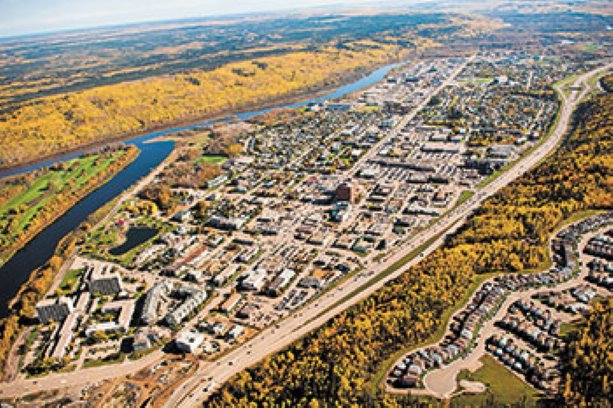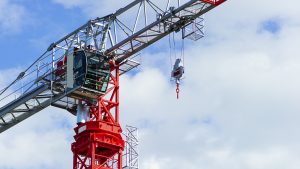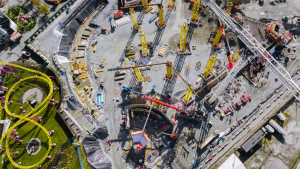The Regional Municipality of Wood Buffalo (RMWB) is undertaking an ambitious construction plan to re-develop almost the entire downtown core of its urban centre.
An estimated four-kilometre stretch of Fort McMurray is destined to be re-developed into a model of sustainable living in the North.
The plan is to move it from the 20th century into the 21st, while evolving from predominantly low density to high.
While mindful of the aim to achieve a zero carbon footprint, this multi-billion dollar plan is aimed at attracting investment and stimulating economic growth.
But it’s more than that, according to Ron Taylor, executive director for development for the city centre, and Carol Theberge, executive director of community development for the RMWB.
Reflecting on the existing downtown core, Theberge admitted that it’s not what people expect from a city that’s generating near double digit gross domestic product.
The oilsands industry has lent itself to the creation of a commuter-type populace.
An estimated 40,000 people don’t call Fort McMurray their home, but are in the city.
“It’s been made easy for people to come here and be temporary,” she said referring to work camps.
Taylor added that a lot of people want to work in Fort McMurray because of the money and availability of good jobs with lots of room for quick advancement, but they don’t want to live here.
They don’t see the community or they don’t want to see the community because it doesn’t fit with the expectations that they have for a place to live, said Theberge.
He acknowledged that sometimes large scale developments can get away from you and in this particular case, they’ve been careful to make sure the plan is practical.
One way to achieve that was using developers to create it, not planners.
That kept it realistic.
“We’ve set very careful metrics,” said Taylor.
“The municipality will be very serious about monitoring that and learning as they go, and making sure the plan is constantly updated to be effective.”
This plan is to be reviewed every five years to ensure its ongoing relevance.
The commercial and residential construction is plotted out until 2030 through the use of a public procurement process offering development opportunities as opposed to traditional tenders.
First shovels are expected in the ground next spring with the creation of a new civic centre with cultural and conference facilities on the waterfront.
Additional features of the plan include an arena to accommodate major sports and entertainment events, a public square to act as a focal point for the downtown and accommodate major public events and gatherings, an improved downtown transit way and pedestrian-friendly walkways including a Rideau Canal inspired thoroughfare on a nearby waterway.
“The new land-use bylaw has really incented larger scale development because in order to be able to accommodate the density that we need to, we have to build a compact, dense efficient city centre and that means that we need to fill our blocks and we need to go up into the air in order to be able to do that,’ he said.
Sustainable building is a priority.
“I personally believe, and our consultants believe that in the future, we will be measuring buildings on the basis of zero carbon footprints,” he said.
Systems would produce steam, hot water or chilled water at central plants.
That energy is then piped to buildings in a district for space heating and air conditioning, getting rid of the need of individual systems.
The city has put together a panel to tackle the challenges.
“We’ve really assembled a really top-notch team to plan and strategize this, and we have a pretty good base to work from. Much of the infrastructure in terms of pipes and servicing has been done,” he said.
“Yes, there are buildings we’ll have to deal with and there will be demolition and there will be remediation, but it’s not onerous.”
That team includes Ron Soskolne, the former chief city planner for the City of Toronto before he moved on to major international developments. It also includes PCL, which has been engaged through a competitive process to assist with construction logistics, scheduling and budgeting.
“They are a firm that understands the north,” said Taylor.
“It’s a firm that we’ve all worked with before, who really are exemplary in terms of their ability to understand how to stage things in a way that is safe, efficient and where ongoing activity occurs.”
The importance of the project hasn’t been lost on PCL.
“The City Centre Area Redevelopment Plan is an important step in outlining the growth of Fort McMurray,” said Alan Kuysters, vice-president and district manager of buildings and civil construction in PCL’s Edmonton office.
“This type of planning is needed to outline the key infrastructure and commercial elements that are required in the community.
“We have experience in building these critical infrastructure and commercial components, and we look forward to having the opportunity to work with the municipality as it fulfills its vision for the city centre.”











Recent Comments
comments for this post are closed